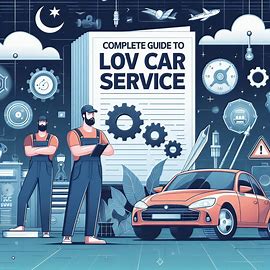
Introduction
Car service is essential for maintaining the safety, performance, and longevity of your vehicle. Whether you’re a new car owner or a seasoned driver, understanding car service can help you save money, avoid unexpected breakdowns, and ensure a smooth driving experience. This comprehensive guide covers all aspects of car servicing—from basic maintenance to understanding the types of services, their costs, and expert tips for keeping your car in top condition.
1. Understanding Car Service Basics
1.1 What is Car Service?
Car service refers to a routine inspection and maintenance process that keeps a vehicle running efficiently. It includes checking engine oil, fluid levels, brakes, lights, tire conditions, and more. Regular servicing ensures that small issues are identified and resolved before they become major problems.
Key components of a basic car service:
- Oil and filter change
- Brake inspection
- Tire rotation and pressure check
- Battery health check
- Fluid top-ups (coolant, brake fluid, transmission fluid)
1.2 Why Car Service is Important
Neglecting car service can lead to severe damage, reduced fuel efficiency, and increased repair costs. Regular maintenance enhances vehicle lifespan, safety, and performance.
Benefits include:
- Improved safety on the road
- Better fuel economy
- Higher resale value
- Compliance with warranty requirements
2. Types of Car Service
2.1 Interim Service
An interim service is a basic check-up usually recommended every 6 months or 6,000 miles, whichever comes first. It includes essential checks and top-ups to keep the vehicle in working condition.
Includes:
- Engine oil and filter change
- Fluid level checks
- Brake, tire, and light inspection
2.2 Full Service
A full service is more comprehensive, usually done every 12 months or 12,000 miles. It includes all interim service tasks plus additional checks.
Includes:
- Air filter replacement
- Fuel system inspection
- Suspension and steering checks
- Exhaust system inspection
2.3 Major Service
A major service is the most extensive and is typically recommended every 24 months or 24,000 miles. It covers all full-service checks plus deep diagnostics and replacements.
Includes:
- Spark plug replacement
- Timing belt inspection
- Brake fluid replacement
- Comprehensive diagnostics
Comparison Table of Car Services:
| Service Type | Frequency | Key Inclusions |
|---|---|---|
| Interim | 6 months / 6,000 mi | Oil change, lights, tire pressure, brakes check |
| Full | 12 months / 12,000 mi | All interim + air filter, suspension, exhaust |
| Major | 24 months / 24,000 mi | All full + spark plugs, brake fluid, timing belt |
3. Car Service Schedule and Costs
3.1 When to Service Your Car
Following the manufacturer’s recommended service schedule is crucial. Most modern cars have dashboard reminders, but always refer to your owner’s manual.
Typical service intervals:
- Every 6,000 miles: Interim service
- Every 12,000 miles: Full service
- Every 24,000 miles: Major service
Factors influencing frequency:
- Vehicle age and mileage
- Driving conditions (e.g., city vs. highway)
- Climate and terrain
3.2 How Much Does Car Service Cost?
Car service costs vary based on the type of service, vehicle make and model, and location. Here’s a general cost breakdown:
- Interim Service: $75–$125
- Full Service: $150–$250
- Major Service: $300–$500+
Cost-saving tips:
- Use independent garages for routine checks
- Look for service bundles or loyalty programs
- Compare quotes from multiple service centers
4. Common Car Service Components
4.1 Engine and Oil Checks
The engine is the heart of your car. Servicing includes checking oil levels and replacing filters to ensure proper lubrication and prevent overheating.
What’s involved:
- Draining old oil
- Replacing oil filter
- Using manufacturer-recommended oil
Signs you need an oil change:
- Engine noise or knocking
- Warning light on dashboard
- Dirty or low oil levels
4.2 Brake System Inspection
Brakes are critical to safety. Regular inspection prevents issues like worn pads or fluid leaks.
What’s checked:
- Brake pads and discs
- Brake fluid level
- ABS system check
Signs of brake issues:
- Squealing or grinding noises
- Spongy brake pedal
- Increased stopping distance
4.3 Tire Maintenance
Tires influence fuel efficiency, safety, and comfort. Servicing includes pressure checks and tread inspections.
What’s done:
- Pressure adjustment
- Tread depth check
- Rotation for even wear
Tire tips:
- Rotate every 5,000–7,000 miles
- Keep pressure as per manual
- Replace tires below 2/32” tread depth
5. DIY Car Maintenance Tips
5.1 What You Can Do at Home
While professional servicing is crucial, there are several tasks you can handle yourself:
- Check and refill windshield washer fluid
- Inspect tire pressure and condition
- Replace cabin air filter
- Clean battery terminals
Tools to keep in your car maintenance kit:
- Tire pressure gauge
- Jack and lug wrench
- Jumper cables
- Funnel and fluids (oil, coolant)
5.2 When to See a Professional
Certain services require specialized tools or skills. Always consult a professional for:
- Engine diagnostics
- Brake repairs
- Suspension or steering issues
- Electrical system faults
Signs you need a mechanic:
- Unusual sounds or smells
- Dashboard warning lights
- Persistent performance issues
Conclusion
Understanding and following a regular car service routine not only keeps your vehicle running smoothly but also prevents costly repairs and enhances safety. With the right mix of professional services and DIY maintenance, you can extend the life of your car and enjoy a stress-free driving experience.